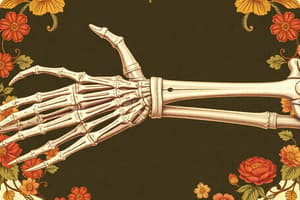Podcast
Questions and Answers
What is the most common type of shoulder dislocation?
What is the most common type of shoulder dislocation?
- Anterior dislocation (correct)
- Superior dislocation
- Posterior dislocation
- Medial dislocation
Who is more prone to experiencing recurrent anterior glenohumeral dislocations?
Who is more prone to experiencing recurrent anterior glenohumeral dislocations?
- Males above 50 years old
- People between 14-25 years old (correct)
- People above 40 years old
- Females aged 25-35 years old
What is the main ligamentous restraint to anterior translation during shoulder dislocation?
What is the main ligamentous restraint to anterior translation during shoulder dislocation?
- Acromioclavicular ligament
- Superior glenohumeral ligament
- Inferior glenohumeral ligament (correct)
- Coracoclavicular ligament
Which nerve should be checked for sensory loss in the lateral deltoid region after a shoulder dislocation?
Which nerve should be checked for sensory loss in the lateral deltoid region after a shoulder dislocation?
What test, if positive six weeks after a shoulder dislocation, is associated with an increased risk of recurrent instability?
What test, if positive six weeks after a shoulder dislocation, is associated with an increased risk of recurrent instability?
What is the recommended investigation of choice for assessing associated pathology in a patient with a traumatic anterior glenohumeral dislocation?
What is the recommended investigation of choice for assessing associated pathology in a patient with a traumatic anterior glenohumeral dislocation?
In an older patient (>40 years) with a traumatic anterior glenohumeral dislocation, what condition must be suspected until cleared?
In an older patient (>40 years) with a traumatic anterior glenohumeral dislocation, what condition must be suspected until cleared?
Which factor is more indicative than pain in an older patient (>40 years) with a traumatic anterior glenohumeral dislocation?
Which factor is more indicative than pain in an older patient (>40 years) with a traumatic anterior glenohumeral dislocation?
What approach is recommended for the management of a patient with lower demands (work/sport) and resolution of symptoms over 6 weeks following a traumatic anterior glenohumeral dislocation?
What approach is recommended for the management of a patient with lower demands (work/sport) and resolution of symptoms over 6 weeks following a traumatic anterior glenohumeral dislocation?
Which mechanism of injury is more likely to result in a posterior shoulder dislocation?
Which mechanism of injury is more likely to result in a posterior shoulder dislocation?
Which muscle group is particularly important to focus on when addressing ongoing posterior instability signs and symptoms?
Which muscle group is particularly important to focus on when addressing ongoing posterior instability signs and symptoms?
What type of exercises are recommended early on for managing posterior dislocation?
What type of exercises are recommended early on for managing posterior dislocation?
What symptom may a patient with posterior subluxation/instability experience during specific movements according to the text?
What symptom may a patient with posterior subluxation/instability experience during specific movements according to the text?
What is the immediate action recommended if a dislocation is not relocated?
What is the immediate action recommended if a dislocation is not relocated?
Which test can be used to assess posterior subluxation/instability in the shoulder?
Which test can be used to assess posterior subluxation/instability in the shoulder?
Flashcards are hidden until you start studying



